The most exciting feature in the animal kingdom is the antlers. Yes, Of course, Animals with antlers spark your curiosity to know what animals have antlers and their purpose.
Well then, In this post, We shall see Animals with Antlers chosen from across the worlds that are all depicted with pictures and explanations as well.
What Animals Have Antlers? Antlers are made of mainly bones, cartilage, fibrous tissue, nerves, and blood vessels that supply minerals for growth and development. Antlers are present in members of the deer family called family Cervidae.
Here is list of animals with antlers
Table of Contents
Female Animals with Antlers:
Reindeer
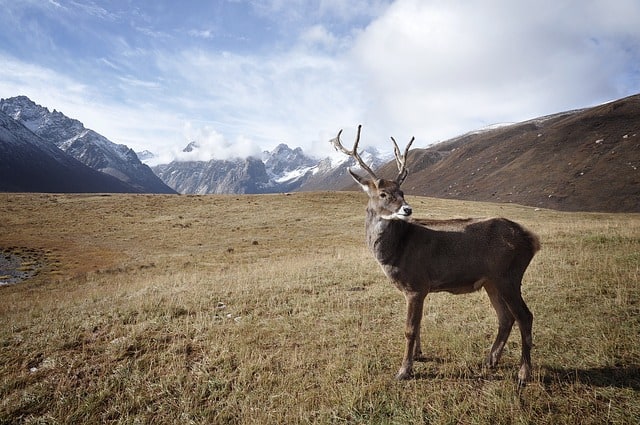
The reindeer, also known as caribou, is a species of deer in the family Cervidae and genus Rangifer that are found in Siberia, Greenland, Scandinavia, Russia, Alaska, and Canada.
In a reindeer species, both males and females have antlers but the male has longer antlers about 50 inches while the females have antlers about 20 inches. A typical antler can grow up to 53 inches in beam length, 40 inches wide. As both male and female have antlers they both shed but at different periods, male reindeer grow their antler during March while the female reindeer grow them in May.
Reindeer have the largest antlers proportionate to their body size among any living deer species. They are the symbol of dominance and so the male deer with large antlers will get most of the mating chance.
African Animals with Antlers:
Red deer

The red deer is the largest-sized species of deer belonging to the genus Cervus and is found in Europe, Iran, Central Asia, northwestern Africa, is a species of deer known to inhabit Africa.
A male red deer is known as a stag, while the female is called a hind. However, Only the males of red deer have antlers that can begin growing in the spring and are shed by the end of winter. Its antlers can grow as much as 30-45 inches and weigh about 1-5 kg and are made of bone.
Surprisingly, antlers of deer that inhabited temperate regions have relatively larger antlers than those living in the tropical region.
North American Animals with Antlers:
Mule deer
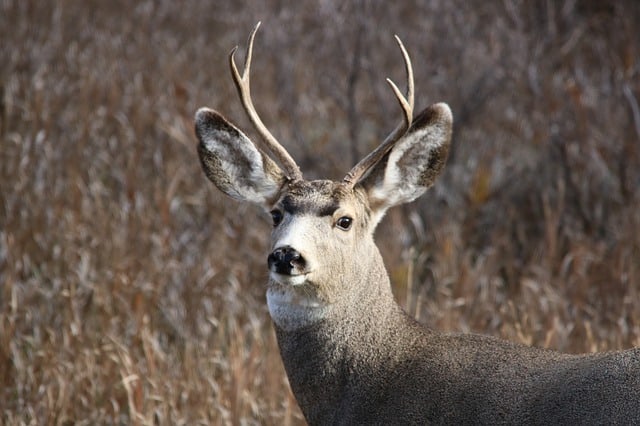
The mule deer is a species of deer that belongs to the Genus Odocoileus and is found in the southwest United States, Missouri River, North American Rocky Mountains, Argentina, Kauai, and Hawaii. These deers are called so because their ears resemble similar to the ears of a mule.
They have bifurcated antlers or forked antlers rather than branched antlers that they regrow almost immediately in each summer season after they are shed in spring. An antler, of course, has two branches on each side, each of them bear 2 tines. Thus mule deer can grow to an average height of 4 feet at shoulder level.
The surprising fact about antlers is that their growth is controlled or regulated by the availability of light in a day.
White-tailed deer
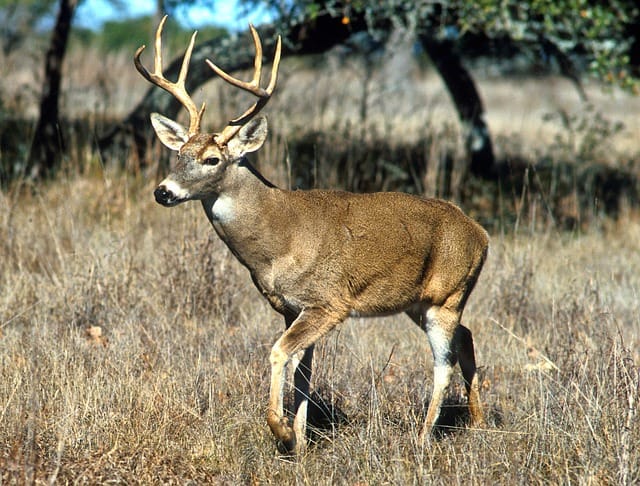
The white-tailed deer, also known as the whitetail, Virginia deer, is a species of deer belonging to the genus Odocoileus and is found in North and Central America, Peru, Bolivia, Texas, Michigan, Mississippi, New Jersey, and other places.
An adult male whitetail deer shed their hardened antlers each year around late December due to the drop in testosterone levels after rut that leads to the activation of osteoclasts which are responsible for the weakening of antler base causing shedding of antlers in a day to weeks.
Elk
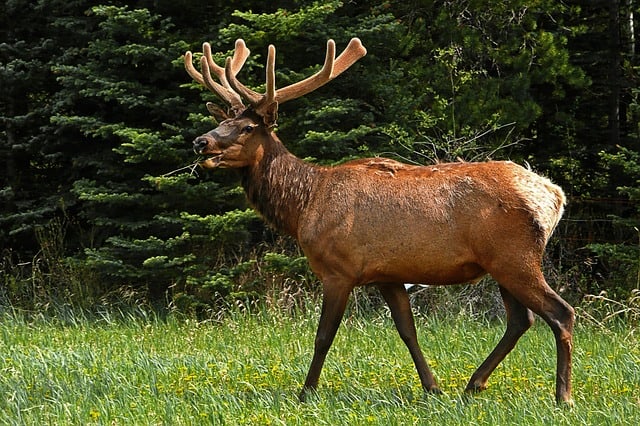
The elk, also known as the wapiti, is one of the largest deer species in the family Cervidae belongs to the Genus Cervus that is found in North America, western North America, Central Asia, and East Asia.
Only male elk deers have antlers that are made up of bone and supported by the velvet, a vascularized tissue supplying blood and mineral to antlers, thus antlers can grow up to a rate of 1 inch per day. Its antlers have about 6 tines on each side of their antlers.
The shedding and growing of new antlers are regulated by the testosterone level that in turn depends on the mating season and length of daylight.
Elk, especially males, use their antlers to defend themselves from predators, mating display, to show dominance, and also to engage in antler wrestling.
Small Animals with Antlers:
Siberian roe deer
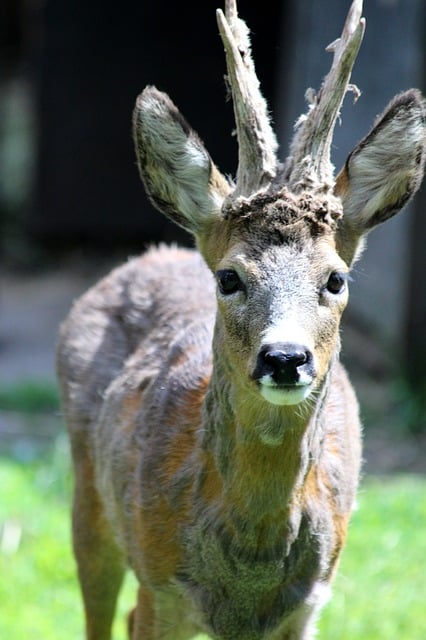
The Siberian roe deer, also known as eastern roe deer, is a species of roe deer that belongs to the genus Capreolus and is found in Siberia, northern Altai, TienshanMongolia, Kazakhstan, eastern Tibet, northeastern China, and other places.
An adult male Siberian roe deer has short antlers with 3 tines or points on each side of the antlers, slanting upward in the direction that makes them reach a height of about 4-5 feet. Interestingly, They grow their antlers during the winter season while other types of deers engaged in the shedding process.
Its antlers, including other deer, protect the skull, eye, ears against the antler puncture that could happen by other animals with antlers, during mating display, territory violence, and showing dominance.
Indian hog deer

An Indian hog deer is a small-sized deer species belonging to the genus Hyelaphus and is found in Pakistan, North Indian states, Cambodia, Nepal, Bangladesh, western Thailand, China, and other places.
These deers have antlers with 3 tines, showing an acute angle between those of the brow tine and main beam. These antlers help them to fight predators, mark territory by scratching them against trees, to show dominance and mating display.
Other Animals with Antlers:
Moose
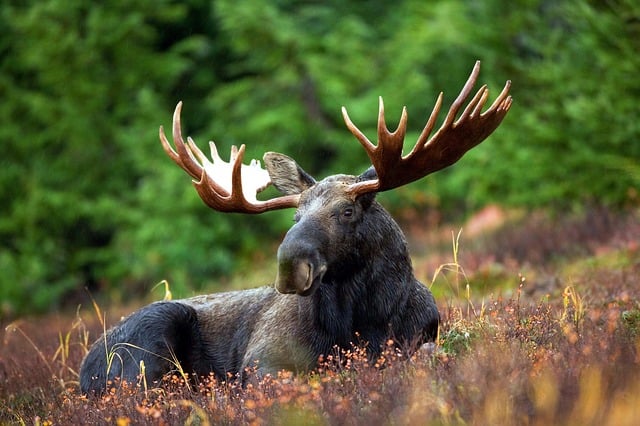
The moose, also known as elk in Eurasia, is the largest species in the deer family Cervidae and genus Alces and are found in Maine, Washington, Canada, Alaska and other places.
Male mooses usually have large antlers that are broad and palmate-shaped antlers called open-hand shaped antlers that can grow up to 6 feet in length and weigh about 30 kg. Every year during winter they shed their antlers that are replaced by growing new ones at the start of spring. Its antlers are used for defending itself against predators, intruders, during mating displays, and also as a sign of dominance.
Shedding of old antlers is thought to be a painless process. However, when we attempt to cut the overgrown antler blood bleeding will occur.
Marsh deer
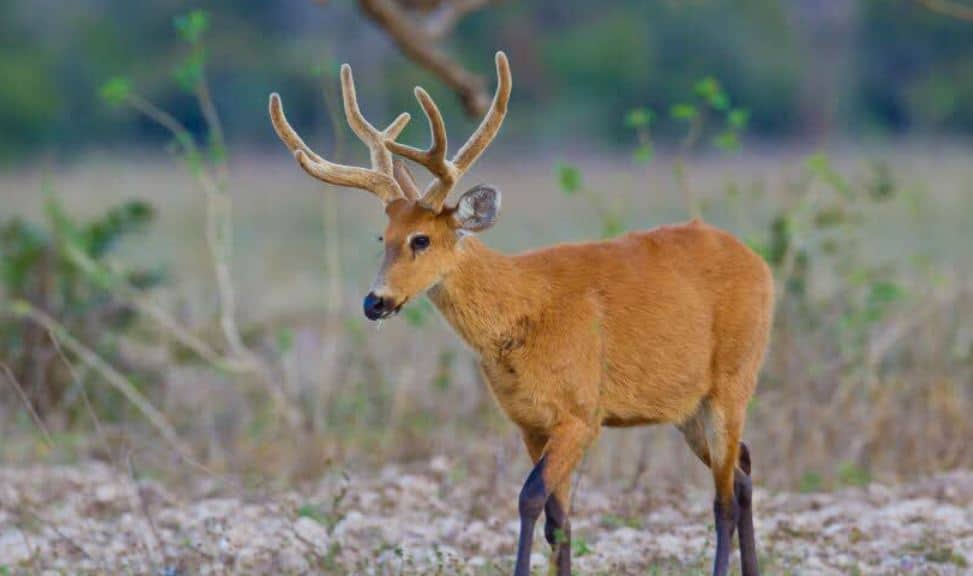
The marsh deer is the largest-sized deer species that weigh as much as 140 kg belonging to the genus Blastocerus and are found in Argentina, Bolivia, Uruguay, Paraguay, Peru, and other places.
They have large antlers that make them reach about 6 feet or 4 feet height at shoulder level. These deer, male marsh deer, have forked antlers that can measure about 2 feet in length.
Barasingha
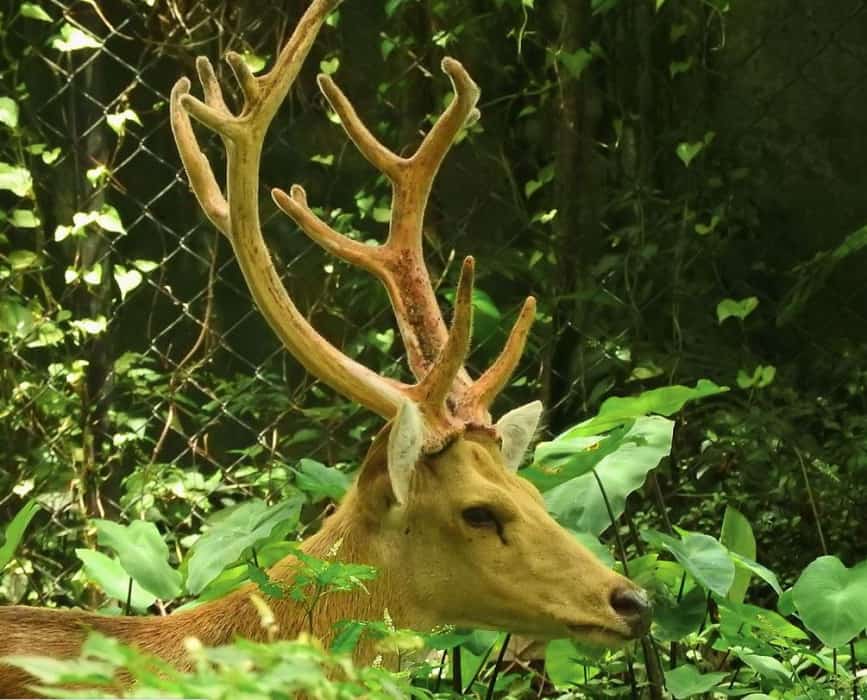
The barasingha, also known as swamp deer, is medium-sized species of deer that belong to the genus Rucervus that are found in southwestern Nepal, Pakistan, Bangladesh, Nepal, and central India.
The swamp deer or barasingha have antlers that are distinct from other Indian deer antlers because swamp deer have large antlers that possess about 10-14 tines. Usually, they have 12 tines in antlers giving them the name barasingha (bara means 12, singha means tines or horns).
Interestingly, some mature male deer possess antlers with as many as 20 tines.
Sambar deer

The sambar deer is a large species of deer weighing about 200 Kg belonging to the genus Rusa and is found in Nepal, India, Southeast Asia, Burma, Thailand, Indochina, the Malay Peninsula, Indonesia, Taiwan, South China, Australia, and the U.S.
Like most of the deers, male sambar deers have large, forked antlers that grow up to 42 inches long and can have three tines. These antlers are used for defending, competing, against another male rivalry to gain female mates.
Read More : Animals With Big noses !
Why do animals have horns and antlers?
Both antlers and horns are the hard structure present on the animal’s head that plays the following roles.
- To protect against predators, especially from carnivores because most of the animals with horns or antlers are herbivores whose only weapon is either horns or antlers.
- To show dominance, They use their antlers or horns to show their dominance without involving rivalry or fights.
- To gain female mates, Males fight each other through their antlers thus the strongest will gain the mate.
Difference between horns and antlers
| Sl. No. | Antlers | Horns |
| 1 | deer family-cervidae | Antilocapridae and Bovidae |
| 2 | All species of Deers such as Moose, Mule deer, Red deer, Elk, | Sheep, Bison, Cattle, Goat, Gazelle, African buffalo, water buffalo. |
| 3 | Sheds each year | Permanent |
| 4 | Composed of bones and velvet. | Keratin |
| 5 | Braches, forked. | Curved, Straight. |
